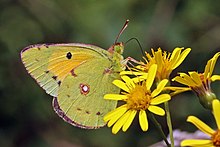Colias croceus
| Clouded yellow | |
|---|---|
 |
|
| Male. Undeside | |
 |
|
| female both, Old Winchester Hill, Hampshire |
|
| Scientific classification | |
| Kingdom: | Animalia |
| Phylum: | Arthropoda |
| Class: | Insecta |
| Order: | Lepidoptera |
| Family: | Pieridae |
| Genus: | Colias |
| Species: | C. croceus |
| Binomial name | |
|
Colias croceus (Geoffroy, 1785) |
|
| Synonyms | |
|
List
|
|
Colias croceus is a small butterfly of the Pieridae family, that is, the yellows and whites. In India and nearby regions it is known as the dark clouded yellow or common clouded yellow to distinguish it from the other species of clouded yellows occurring there; elsewhere it is often simply known as the clouded yellow, as it was the first and original butterfly to go by this name.
All said forms are usually considered synonyms of Colias croceus.
Colias croceus is one of the most-widespread species in Europe. The common clouded yellow's breeding range is North Africa and southern Europe and eastwards through Turkey into the Middle East but it occurs throughout much of Europe as a summer migrant, in good years individuals reaching Scandinavia. In Asia, its range extends into central Siberia in the north and barely into India in the south; it is not found in Central Asia.
This species is primarily an immigrant to the UK, originating southern Europe and from northern Africa. In the UK they can be seen on the south coast almost every year in varying numbers, and regularly breed there. Occurrence in the rest of the UK varies considerably from year to year, but they are increasingly observed as far north as Dumfries and Galloway. It has also been recorded in Ireland from the Raven, Co. Wexford.
A truly migratory European butterfly, this species is famous for occasional mass migrations and subsequent breeding, which are often referred to in the United Kingdom as "clouded yellow years". Notable clouded yellow years include 1877, 1947, 1983, 1992, 1994, 1996 and 2000.
These butterflies may live in any open area in the countryside, including downland, coastal cliffs and fields containing the caterpillar’s host plants, at an elevation up to 1,600 metres (5,200 ft) above sea level.
...
Wikipedia
